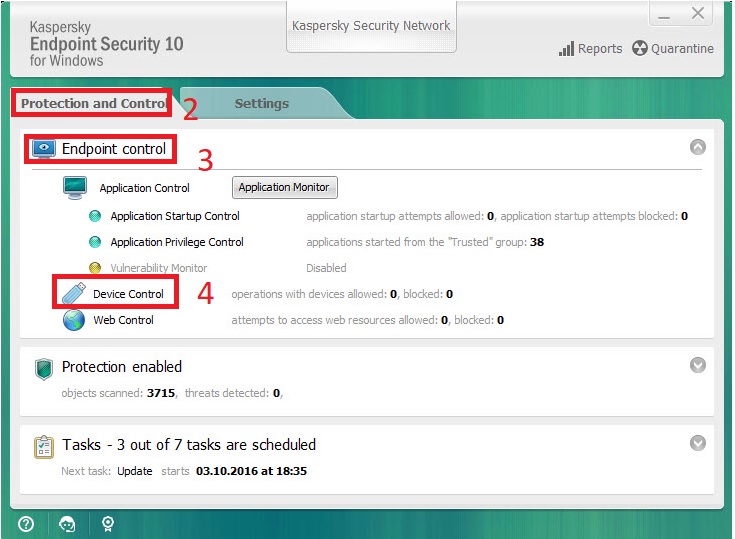
- #Kaspersky endpoint 10 device control install#
- #Kaspersky endpoint 10 device control Patch#
- #Kaspersky endpoint 10 device control pro#
- #Kaspersky endpoint 10 device control license#
#Kaspersky endpoint 10 device control pro#
Similarly, web control comes as a default with many solutions including Avast Business Antivirus Pro Plus (ABAPP), but isn’t available by default with Kaspersky’s endpoint platform. Worst still, you’ll get many of them with its peers, as part of the standard offering.įor instance, there’s device control, which is part of the standard package for many endpoint security products such as Bitdefender GravityZone Advanced Business Security. While there isn’t anything inherently wrong with Kaspersky’s endpoint offering, most of the useful features are only available with the more expensive Plus edition. For every endpoint, you can secure two devices for free. The good thing about Kaspersky’s pricing is that it doesn’t charge you extra for protecting mobile devices.
#Kaspersky endpoint 10 device control license#
SImilarly, a 2 year license for 20 devices costs $922.50 or about $23/device/year. A 2 year license for 10 devices costs $543.75, which comes to about $27/device/year. You’ll also find it cheaper to subscribe for a couple of years. For instance, protecting 20 devices for 1 year will cost $547.50 or about $27/device. As is usually the case, protecting more devices will reduce the cost per device. Protecting 10 devices for 1 year will cost $322.50 or $32.25/device. Unlike some of its peers, if you choose to use Kaspersky’s endpoint solution you’ll have to purchase a license for a minimum of 10 endpoints. (Image credit: Kaspersky) Plans and Pricing
#Kaspersky endpoint 10 device control Patch#
However as per Kaspersky’s website these features are only available in the Cloud Plus platform and should have been disabled just like Cloud Blocking and Patch Management. Surprisingly, during our tests we could enable and customize the device control, web control, and encryption management features from the interface, and they worked flawlessly. Under management settings, you can tweak the other features such as cloud discovery. You can also drill down and configure each one of them as per your needs. Under security settings you can choose to enable or disable the file, web, mail, network security protections as well as the firewall. These are broadly classified into security settings and management settings. The security profile contains the parameters for all supported operating systems. The platform has a default policy to help you get started, but you can easily create one as per your requirements. Once you’ve added the endpoints, you’ll need to assign them to a security profile.
#Kaspersky endpoint 10 device control install#
On servers though you can manually download and install the client from the administration wizard.

If you have an Active Directory server on the network, you can also ask the administration wizard to use it to deploy the client on multiple endpoints automatically. The platform will then send an email to all of them with instructions to download and install the endpoint client on their respective machines. The recommended procedure is to add users, which are the administrators for the different endpoints along with their email addresses.

The platform offers multiple mechanisms for deploying the endpoints. One of the good things about the interface is that the main landing page displays the steps you need to take, in order of their priority, to configure the platform.

You can enable and configure some features during initial setup or choose to do it later. When you first sign into the administration wizard, you’ll be taken through a quick setup wizard to customize it for your company. You can manage the Kaspersky endpoint security platform via its cloud-based interface. (Image credit: Kaspersky ) Interface and use


 0 kommentar(er)
0 kommentar(er)
